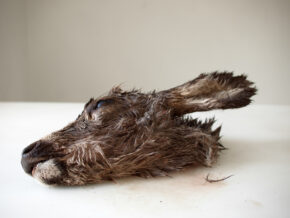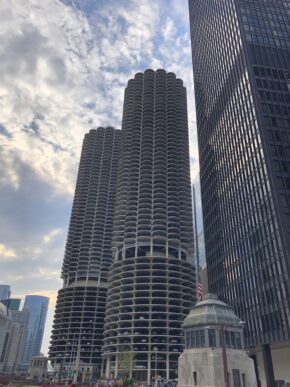“There is no better feeling than stumbling upon genius of which you were completely unaware!”
That’s what I jotted in my little notebook. I normally eschew exclamation points, but in this case, it was quicker than going with ALL CAPS. Dropping an exclamation point at the end of that sentence was my way of speaking to my future self. This is so brilliant, JB! You can’t forget how brilliant it is, JB! Never Forget!
About what was I jotting shoddily coded messages, scribbled in fourth-grade quality handwriting? I was in an art exhibition featuring the best work I saw this year that I haven’t already written about yet.
Ah yes. My iconoclastic version of a “best of” column. Of course I’m far too “rebellious” to just do a “best of” photobook list, like everyone else. Each year, I do it my own way, and it has managed to kick off an unexpected sh-tstorm two years running.
Not this year. Oh no. I’m going to tweak my own rule a bit. Did you notice the column was titled “work” this year, rather than photos? We’re exploiting a technicality so I can present to you “Portraits.” by Luc Tuymans, recently published by Yale University Press and the Menil Collection.
There I was, standing in the middle of Mr. Tuymans’ exhibition, “Nice,” at the Menil Collection in Houston last month, when I wrote the aforementioned note. Please, remember how good this is, I said to myself. Go out into the world and tell the masses. Visit this free exhibition. It’s a soul colonic in these holiday-season-over-eating-meat-fest times. (The exhibit is on view through January 5th.)
Truth be told, I talked two random strangers into coming inside before I even got to the front door. A young, African-American couple called out to ask me directions to the Rothko Chapel. I told them they needed to follow me inside first, before walking the block-and-a-half up the tree-lined street. So they did.
The reason this column is long this week, in addition to my overly-ambitious espresso consumption on Christmas Eve morning, is that this exhibition was the antipodal node to the Mike Kelley exhibit I saw in Amsterdam in the spring. (Which is currently on view at MoMAPS1.)
If you don’t recall, that was the mid-life-crisis-inducing art exhibit I wrote about in April. It gave me a near-panic attack about just being mortal; not a transcendent genius for all time. Oh the shame! I was upset at first, as Mr. Kelley’s manic, dystopic mastery over so many media meant I was far more pedestrian than my ego had previously led me to believe.
It hurt like a hemorrhoid. Yes, a hemorrhoid popped up on my soul for a few hours. Shrieks rang out in my ears, first of pain, and then of joy. I was liberated; free to just be a regular artist who loves spending time with his family, and watching soccer games on the TV each weekend.
I was free to make my art because I wanted to, not because future art-historians were playing space-jenga while waiting for my works to wind their way through time. I could feel the pulse of Mr. Kelley’s illness as it pervaded the unbelievably excellent objects before me. It was unsettling genius, and I grew to like the feelings it evoked. Eventually.
Fast Forward to November of the same year. I was visiting Houston, as I had photographs in an exhibition at the Houston Center for Photography, which is one block from the Menil Collection. One might say it was destined that I see Mr. Tuymans’ show.
The book is all I have to show you, so show you I will. I mentioned a technicality earlier, and it’s this: the art objects I’m describing are reproduced here as photographs. So…technically…this is a photobook review.
Without exaggeration, I went back into the show, “Nice,” four times over a two hour period. Here’s why.
The exhibition opens with a metaphorical and literal trinity: a Spanish Colonial wooden head of Christ, a primal-looking bronze-age mask from Syria, and a small painting of a cropped Old Man’s head called “Donation,” from 2005, by Luc Tuymans. The triumvirate spoke with an authoritative but quiet voice: “Art has been a part of culture for as long as culture has existed. As has the worship of powers unknowable.”
I spent precious minutes with everything I would soon encounter, staring in wonder. The energy radiating off the objects was so intense, I felt as if red-and-black ants were gnawing on my toes. Religious fervor, the angst of death, the seduction of power, the wonder of creation, all these messages were pulsing through the space.
The mask was a predominant theme throughout, almost always giving me the joyous willies. One piece, from Vancouver Island, found/taken by Captain James Cook, sat beside what I was sure was a ceramic death mask of André Breton. Creepy-tastic.
The book confirms that Mr. Breton was alive at the time, so the piece was not actually a death mask. It just really, really seemed like one. That the two pieces shared a room with an austere portrait of Condy Rice should tell you all you need to know about how a certain dry humor can seep into even a room filled with eerie remnants of the past.
I should probably say something about Mr. Tuymans’ paintings, as they manage to both anchor the space, and hold their own with these ancient companions, which I was told he selected himself. The work manages to be primal and poetic, contemporary but elegiac. It’s all about balance, and he almost always gets it right. (One notable exception was the painting, “Iphone,” but everyone’s allowed a mulligan.)
The palette is stripped down. Super-subtle. Almost pastel. At one point, as I stared, I thought I could detect the legacy of Monet. But the colors are always beautiful and succinct. They go together like candy canes and Christmas.
As I admitted, I didn’t know who he was before I stumbled upon the show. (Though I had heard his name before.) So I began to piece things together, over the four trips, and even found myself discussing things with fellow viewers. (Is he French or German? I don’t know. Could be either. Luc is a French name, but the work seems more Germanic to me? We wondered.)
Turns out, he’s Belgian, and I could see the imprint of both the French and Flemish influences. The deft handling of light made me think of the Dutch tradition, and the sense of eccentric whimsy, just on this side of good taste, made me think of the French.
There were paintings of Jesus, politicians, war criminals, religious figures, and other things as well. (Including masks.) One portrait, titled “Portrait,” from 2000, held me rooted to the wood floor. It was the eyes. They were beatific. Glowing.
They connected perfectly with the Egyptian encaustic paintings, from the Roman era, to be found in another room. Haunting eyes. Eyes that were meant to be preserved by conservators until the Giant Rats take over. (If you doubt me, read the brilliant two-part series by Elizabeth Kolbert in the New Yorker this month. Apparently, giant hairless rats of the future might start wearing the skins of the creatures they kill, like futuristic-cave-man-monsters. At least we won’t be around to see it…)
In the book, which provides background material for the objects and paintings, I learned the painting was a cropped rendering of a photo of a gay man showing off his tattoos for a lover. An unfamiliar woman and I chatted about whether it was a self-portrait, so sure were we there was a reason why the painting had extra oomph.
Tuymans, again in balance, manages to present his work in the context of historically important art, while still communicating that he’s doing it for the right reasons. He comes across as merely another artist plugging away, unsure what people will do with his pictures when he’s dead and gone. (Albeit a wildly talented one.)
There was a light-absorbing Ad Reinhardt painting about, and a giant gold leaf piece by Yves Klein shimmered like heat waves rising off of the Mojave pavement at 4pm in summer. You notice an abstraction of yourself in its reflection, almost as if you’re rendered by Tuymans in gold.
Picasso made an appearance, as they were displaying a piece that had been attacked by an insane art student in the recent past, and then restored. I noted to myself that when Picasso becomes an after-thought, you know you’re in a very special place.
The references to death, religion, and history are inescapable. I was haunted by a Gothic stone headpiece from France, and it’s certain to pop up in my dreams in the next few years. (Creepy dead stone French guy, go bother someone else.)
Basically, this exhibition was life affirming, while Mr. Kelley’s was ultimately nihilistic. It reminded me I had no idea what people would think of my work after I died. No one can know that. So it ought not be why we make it. Do it for now, for you, not for those jenga-playing-future-historians.
That’s what was so genius! about this exhibition, and why you should go, if you can. In combining the Old with the New, it reminds us that the urge to create and collect is timeless.
But we are not.
The craftsman who carved that Spanish Colonial Christ head, at the entrance, could not possibly have conceived of the place where his work currently resides. It would appear in his mind as a fantasy, like the first sailing ships seen by Native Americans.
What a refreshing reminder. Make things because you want to. Because it gives you joy. That’s what I took away from Luc Tuymans’ exhibition. We’re here for a short while, and then dead forever. Give it all you’ve got.
I’d like to imagine that Mr. Kelley and Mr. Tuymans crossed paths on the Super-Duper-Art-Star circuit one day. Perhaps in Basel, or Beijing. Maybe Mr. Tuymans put his hand on Mr. Kelley’s shoulder, coldly looked him in the eyes, and nodded. Empathetically.
And maybe Mr. Kelley, eyes despondent, nodded back and smiled. Mr. Tuymans might have gripped and squeezed his counterpart’s shoulder, in an avuncular way, and smiled back. Then they parted, each to schmooze a different billionaire collector.
But maybe, just maybe, Mike Kelley went home that night, looked in the mirror, and decided he could fight back his demons for a few more days.
That’s all I’ve got for you in 2013. Stay strong. Keep going. And if the giant hairless rats knock at your front door, just tell them you’re not home.

















